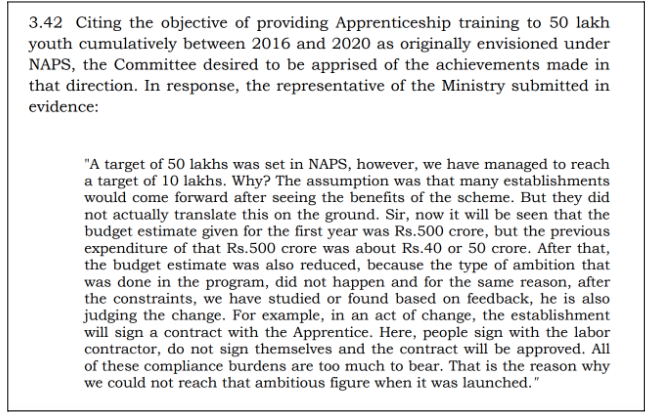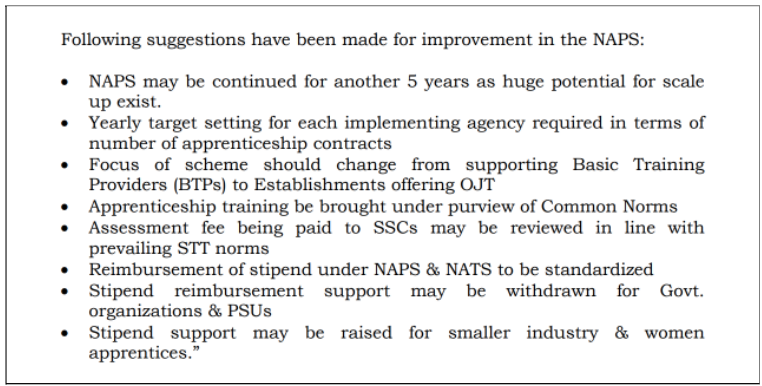The Parliamentary Standing Committee of Labour, Textiles and Skill Development recently submitted a report on the implementation of NAPS. Among other things, it noted the low achievement of enrolment under the scheme against the stated targets. The government highlighted low expenditure, and compliance costs as possible reasons. Here is a review.
‘It is not the quantity, but the quality that actually matters.’ We all must have heard this line at some point in our life. While it might not be true in every case, it is mostly true in the case of employability. Organizations often look for quality (Employable Skills) in the potential candidates and not on the available pool of workforce (quantity).
It is in this context, we look at the National Apprenticeship Promotion Scheme (NAPS) introduced by the Government of India (GoI) and what the parliamentary standing committee had to say about this scheme.
India’s median age by 2022 will be 28, well below other developed nations like the United States and China. That effectively means the working-age population is greater than the non-working age group. Also called ‘Demographic Dividend’, this is touted to have the potential to re-write India’s economic growth and put India at the top of the world. However, only 4.69% underwent formal training as compared to 52% in the USA, 80% in Japan and 75% in Germany, as per the ‘2015 National Policy for Skill Development & Entrepreneurship’ document of the Ministry of the Skill Development & Entrepreneurship (MSDE). If left unnoticed, this could well turn the demographic dividend into a liability from being an asset. To reap the benefits of the demographic dividend, India must generate both employment as well as prepare its workforce with employable skills.
Transformations are happening at a rapid pace across multiple sectors of Industry. The advent of digital technologies, automation and artificial intelligence brought with them huge disruptions in the market, driving the requirement for new learning curricula and skilling strategies. Skilling, re-skilling, and upskilling is the only formula to stay relevant in these ever-changing market conditions. Governments have been implementing multiple schemes related to skilling over the years.
This story is primarily based on the Standing Committee of Labour, Textiles and Skill Development’s report on the implementation of the NAPS/ National Apprenticeship Training Scheme (NATS), with inputs from parliamentary questions.
The evolution of Apprenticeship
Any form of Skilling has two main components- theory, and practice. Teaching at institutions must be supplemented by practical training at the workplace. Apprenticeship is recognized as the best strategy to impart practical training using the existing industrial facilities, way back in the 1960s. Initially, it was voluntary under the National Apprenticeship Scheme 1959, but with the enactment of The Apprenticeship Act, 1961, the act of providing apprenticeship had become mandatory. The coverage of this act was initially limited to trade apprentices, which was subsequently expanded to cover graduates, technicians, technicians (vocational) and optional trade apprentices by amendments in 1973, 1986 and 2014 respectively.
A separate Ministry of Skill Development and Entrepreneurship (MSDE) was formed in 2014 to achieve the vision of ‘Skilled India’. The primary responsibility of MSDE is to coordinate skill development efforts across the nation, bridge the gaps between the supply and demand of a skilled workforce, and build a technical training framework for existing jobs as well as expected future jobs. In 2015, the Ministry launched Skill India Mission to train over 40 crore people by 2022. The same year, the apprenticeship was transferred from the Ministry of Labour and Employment to MSDE.
Apprentice Protsahan Yojana (APY) was launched on 16 October 2014, with the Government of India sharing half of the statutory stipend with apprentices for the first two years of training for one lakh apprentices to be hired by establishments by March 2017. Only 970 apprentices were trained in 609 registered industries till 18 August 2016. To encourage apprenticeship training vigorously, APY has been replaced by the ‘National Apprenticeship Promotion Scheme’ (NAPS), which was announced on 19 August 2016. It is envisioned under MSDE, and the primary objective is to incentivize the employers to recruit apprentices by sharing 25% of the stipend costs, with a target to train 50 Lakh youth during 2016-17 and 2019-20. It envisions a better outreach and engagement strategy and aims to provide a transparent system of operations. More on the objectives and goals of NAPS are explained below.
A similar program to incentivise the employers already exists- the National Apprenticeship Training Scheme (NATS), wherein the government finances 50% of the stipulated stipend costs (http://portal.mhrdnats.gov.in/). This scheme is under the Ministry of Education and covers only ‘Graduate apprentices’ and ‘technician apprentices’, the rest are covered under NAPS. Key similarities and differences are explained in detail in the Standing committee Report.
Enrolment is far below the set target under NAPS
As stated earlier, the target of NAPS was to train 50 Lakh youth during 2016-17 and 2019-20. As per the amendments made to the Apprenticeship Act, 1961, it is mandatory to engage apprentices in the band of 2.5% to 15% (increased from 10% on the recommendation of the expert committee) of the total manpower including contractual staff for establishments with 30 (reduced from 40 on expert committee recommendation) or more strength. This limit is fixed keeping in mind the availability of infrastructure, key trainers, etc. so that apprentices can gain meaningful training without stressing establishments. However, out of 1,41,473 establishments registered on the portal, only 25,832 were engaging apprentices as mentioned in a reply to the parliament question from December 2021. A total of 13,38,995 candidates were trained from the inception of NAPS till 14 December 2021. Year-wise breakup is given below.
The committee went further to enquire about the status of enrolments and registration of establishments in the portal. Both grew steadily over the last few years, but this growth is not in accordance with the expected objective of the scheme.
The committee enquired about the status of apprenticeship engagement by the establishments and in-depth detail on the band-wise recruitments. The Ministry submitted that a total of 1,19,168 establishments were registered on the portal, out of which only 24,603 were currently engaging in apprenticeships. Most of these establishments engaged apprentices in the band of 2.5% to 10%. A total of 15,651 establishments were registered on the portal that has manpower strength between 4-29, and only 2,517 of these were engaging in apprenticeships in the 2.5% to 15% band.
No Enforcement Mechanism
The committee went further and asked about the penal provisions for non-compliance. The representative of the Ministry mentioned that the enforcement mechanism as of now is almost nil. The penalty for non-compliance is low compared to the payment made by the non-engagement of apprentices. Earlier there was a provision for criminalizing non-compliance, which was removed in 2014.

The committee then enquired about the issue of absorption/retention post the apprenticeship period. The Ministry responded that the employer is not bound legally to provide such an offer unless it is explicitly mentioned during the signing of the contract.
Compliance Costs could be the reason for low enrolments
The committee then wanted to know the achievements till date as against the stated objective of apprenticeship training for 50 Lakh youth between 2016 to 2020. The Ministry responded that the achievement is only about 20% of the desired. One of the major reasons mentioned behind such dismal performance is the compliance costs.

Very low expenditure under NAPS over the years
Upon the submission of the Ministry regarding the low actual expenditures, the committee asked the Ministry to provide the details of the financial allocations and the actual expenditures made since the inception of the scheme. The actual expenditure for the scheme has been very poor.
When asked about the effectiveness of amendments made to the Apprenticeship Act, 1961, the Ministry informed about the ‘Impact Evaluation Study of National Apprenticeship Promotion Scheme (NAPS)’ conducted by the National Productivity Council (NPC). The key findings of the NPC are:
- Higher completion rate of greater than 90% for apprenticeship training.
- Better employability prospects, with 64% getting employment within 6 months and 74% within 12 months after passing out.
- Practical training is valued more than theoretical training by 85% of the respondents.
- Stronger Employability prospects compared to a non-certificate holder were felt by 68% of respondents.
The study also provided some recommendations to improve the performance of NAPS.

On the steps taken to minimize the impact of COVID-19 on apprentices, the Ministry responded that the apprentices were provided the flexibility to join back the program which they left earlier. In addition, the training programs were extended, and the establishments were asked to provide stipends during this period.
Status of NATS:
The Committee also reviewed the implementation of the NATS scheme. The Minimum rate of stipend for graduate apprentice (degree holder) and technical apprentice (diploma holder) is Rs. 9000 and Rs. 8000 respectively, out of which 50% is reimbursed to the industry. On the query of the committee regarding the revision of stipends, the Ministry agreed with the upward revision to Rs.18,000 for graduate apprentices and Rs.15,000 for technical apprentices per month. On whether establishments with sound financials were discouraged to seek reimbursements, the Ministry responded that it is up to the establishment whether to seek reimbursements and there is no pressure from the Ministry.
The committee was then apprised of the recent budget announcement in 2021 about the allocation of Rs. 3000 Crores for the realignment of NATS towards post-education apprenticeship from 2021-22 to 2025-26. Around 3270 industries offered apprenticeships during the last three years and nearly 70% of these industries engaged less than 100 apprentices. The below graph depicts the region-wise contacts created under NATS from April 2016 till April 2021.
Recommendations by the Committee:
On hearing the Ministry’s responses, the committee came up with the following recommendations to improve the performance of NAPS as well as NATS.
- Integration of NAPS and NATS
- Both have a similar objective, but a few fundamental differences here and there.
- To promote uniformity in operations, the committee desired that efforts must be made to promote consistent and integrated characteristics for seamless execution.
- Areas for simplification in working out a unified portal for both NAPS and NATS must be identified and worked out.
- Stipend
- The committee is convinced that the disparities in the share of reimbursement in stipends between both the schemes are not beneficial to either of them.
- Accordingly, the committee recommended increasing the stipends under the NATS, as well as restoring parity by enhancing the reimbursement share to a sizeable extent under NAPS.
- Timely payment of reimbursements to MSMEs should be facilitated to encourage more recruitment.
- Industry Interface
- The committee took note of the low level of engagement of the industry with the apprentices. It also rejected the Ministry’s contention that a job guarantee results in laxity during the training period.
- Accordingly, the Committee insisted both MSDE and the Ministry of Education conduct periodic reviews of the causes behind low-level engagement by industry and act accordingly.
- Public Awareness
- The committee recommended that efforts must be made to put in a mechanism to spread more awareness and popularise the programmes. It also desired that public representatives be involved for effective dissemination of information which is beneficial to both industries and apprentices.
- Miscellaneous suggestions
- Periodic updates and expansion of trade categories for effective absorption of a greater pool of labour for skill development.
- Both the ministries are suggested to strengthen their monitoring mechanisms for maintaining the effectiveness and output of the programs.
Featured Image: National Apprenticeship Promotion Scheme


